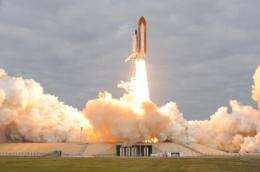New Endeavour for an MIT experiment

Space Shuttle Endeavour’s final mission, launched May 16, has successfully delivered MIT researchers’ Alpha Magnetic Spectrometer (AMS) — an instrument designed to use the unique environment of space to search for antimatter and dark matter and to measure cosmic rays — to the International Space Station.
The principal investigator of the AMS experiment is Samuel Ting, the Thomas Dudley Cabot Professor of Physics at MIT, who led the design, construction and commissioning of AMS with his Electromagnetic Interactions Group at the MIT Laboratory for Nuclear Science. Ting shared the Nobel Prize in physics in 1976 with Burton Richter ’52, PhD ’56 for discovering the J/Psi particle, a heavy elementary particle.
The AMS experiment is designed to study high-energy particles; such study could lead to new theories about the formation and evolution of the universe.
“We can look for dark matter, look for antimatter and look for strangelets,” Ting said at a news conference pegged to Endeavour’s launch. “But to advance in physics is to push current knowledge aside. Exploring new territory with a precision instrument is the key to discovery. What we will really see, nobody knows.”
“The most exciting objective of AMS is to probe the unknown: to search for phenomena which exist in nature that we have not yet imagined nor had the tools to discover,” Ting added.
The original agreement to develop the AMS experiment for the International Space Station was signed by NASA and the U.S. Department of Energy (DOE) in September 1995. An AMS prototype first flew aboard Space Shuttle Discovery in 1998.
Since then, the AMS — developed by scientists from 60 universities and research institutions in 16 countries — has overcome significant challenges. Following the Space Shuttle Columbia accident in 2003, AMS was removed from the shuttle’s launch manifest. Ting and others led an aggressive campaign to restore a dedicated space shuttle mission to the launch schedule. The NASA Authorization Act of 2008 included language specifically allocating an additional space shuttle mission for the AMS experiment, and NASA officially approved the STS-134 mission to launch AMS in January 2009.
With AMS now in place, “the International Space Station will transform into a high-energy physics laboratory, with access to the most powerful accelerator in the universe, which is the universe itself,” said Saul Gonzalez of the DOE’s Office of High-Energy Physics.
In addition to Ting, the AMS leadership team includes Manuel Aguilar-Benitez of CIEMAT in Madrid, Spain; Silvie Rosier of the National Institute of Nuclear Physics and Particle Physics in France; Roberto Battiston of the University of Perugia in Italy; Shih-Chang Lee of the Academia Sinica, Institute of Physics in Taipei, Taiwan; Stefan Schael of the Physics Institute in Aachen, Germany; and Martin Pohl of the University of Geneva in Switzerland.
Provided by Massachusetts Institute of Technology





















